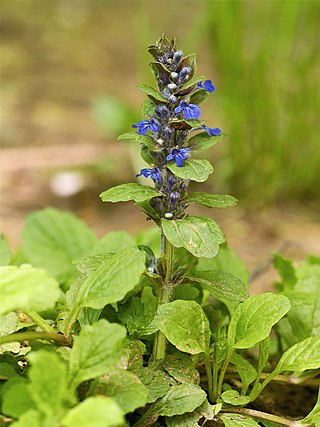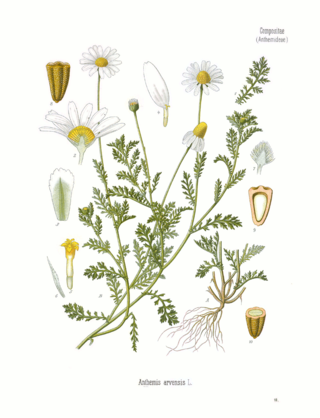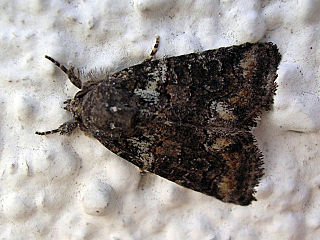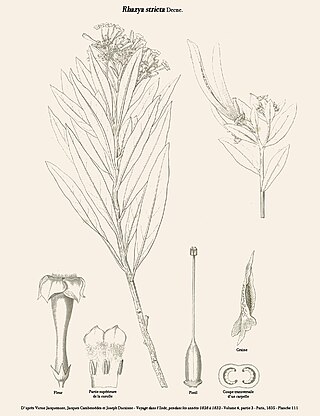
Satureja is a genus of aromatic plants of the family Lamiaceae, related to rosemary and thyme. It is native to North Africa, southern and southeastern Europe, the Middle East, and Central Asia. A few New World species were formerly included in Satureja, but they have all been moved to other genera. Several species are cultivated as culinary herbs called savory, and they have become established in the wild in a few places.

Daphne is a genus of between 70 and 95 species of deciduous and evergreen shrubs in the family Thymelaeaceae, native to Asia, Europe and north Africa. They are noted for their scented flowers and often brightly coloured berries. Two species are used to make paper. Many species are grown in gardens as ornamental plants; the smaller species are often used in rock gardens. All parts of daphnes are poisonous, especially the berries.

Ajuga, also known as bugleweed, ground pine, carpet bugle, or just bugle, is a genus of flowering plants in the Ajugeae tribe of the mint family Lamiaceae. There are over 60 species of annual or perennial, mostly herbaceous plants. They are native to Europe, Asia, Africa, and Australia.

Gagea is a large genus of spring flowers in the lily family. It is found primarily in Eurasia with a few species extending into North Africa and one species in North America.

MENA, an acronym in the English language, refers to a grouping of countries situated in and around the Middle East and North Africa. It is also known as WANA, SWANA, or NAWA, which alternatively refers to the Middle East as West Asia, this is another way to reference the geographical region, instead of using the more common political terminology.
Pirzada is historically described as official custodians of Sufi mausoleums and shrines in Muslim lands, with their earliest mentions being in Baghdad, Iraq, during the period of the Ilkhanate, Timurids and Mamluks. Often a Pirzada was a descendant of those buried within the tomb they were assigned to, hence most of the Pirzadas are successor to Saint buried in the tomb.

Anthemis arvensis, also known as corn chamomile, mayweed, scentless chamomile, or field chamomile is a species of flowering plant in the genus Anthemis, in the aster family. It is used as an ornamental plant.

Galium spurium, the stickwilly or false cleavers, is a plant species of the Rubiaceae. It is widespread across Europe, Asia, Africa and Canada, and is naturalized in Australia. It is considered a noxious weed in many places.

Micromeria is a genus of flowering plants in the mint family, Lamiaceae, widespread across Europe, Asia, Africa, and North America, with a center of diversity in the Mediterranean region and the Canary Islands. It is sometimes placed within the genus Satureja. The name is derived from the Greek words μῑκρος (mīkros), meaning "small," and μερίς (meris), meaning "portion," referring to the leaves and flowers. Common names include savory and whitweed.

Senecio glaucus is an annual member of the Asteraceae and species of the genus Senecio. It is found from the western Mediterranean to Central Asia in sandy, well-drained soil, particularly coastal and desert dunes.

Bryophila is a genus of moths of the family Noctuidae. The genus was described by Treitschke in 1825.
Content from the United States diplomatic cables leak has depicted Saudi Arabia and related subjects extensively. The leak, which began on 28 November 2010, occurred when the website of WikiLeaks — an international new media non-profit organization that publishes submissions of otherwise unavailable documents from anonymous news sources and news leaks — started to publish classified documents of detailed correspondence — diplomatic cables — between the United States Department of State and its diplomatic missions around the world. Since the initial release date, WikiLeaks is releasing further documents every day.

The term Axis of Resistance refers to an anti-Western, anti-Israeli, and anti-Saudi political and informal military alliance between Iran, militant groups in Palestine, the Syrian Government, and the Lebanese militant group Hezbollah. Pro-Syrian Ba'athist militias, Iraqi Shia militias that are part of the Iraqi Government-sanctioned Popular Mobilization Forces, and the Yemeni Houthi movement are also considered part of the alliance.
Coniothyrium is a genus of fungi in the family Coniothyriaceae. The genus was circumscribed by Czech mycologist August Carl Joseph Corda in 1840. It was formerly placed in the Phaeosphaeriaceae family until 1983 when the family was established.

Rhazya is a genus of plant in family Apocynaceae first described as a genus in 1835. It is native to Egypt and to southwestern Asia from Yemen to India.

Iran and Saudi Arabia are engaged in an ongoing struggle for influence in the Middle East and other regions of the Muslim world. The two countries have provided varying degrees of support to opposing sides in nearby conflicts, including the civil wars in Syria and Yemen; and disputes in Bahrain, Lebanon, Qatar, and Iraq. It also extends to disputes or broader competition in other countries globally including in West, North and East Africa, South, Central, Southeast Asia, the Balkans, and the Caucasus.

Seidlitzia a genus of flowering plants belonging to the family Amaranthaceae. It is also in the Salsoloideae subfamily.

This is a list of the Saudi Arabia national football team results from 1957 to 1979.

Noaea is a genus of flowering plants belonging to the family Amaranthaceae. It is in the Salsoloideae subfamily.
Savignya is a monotypic genus of flowering plants belonging to the family Brassicaceae. It only contains one known species, Savignya parviflora(Delile) Webb















